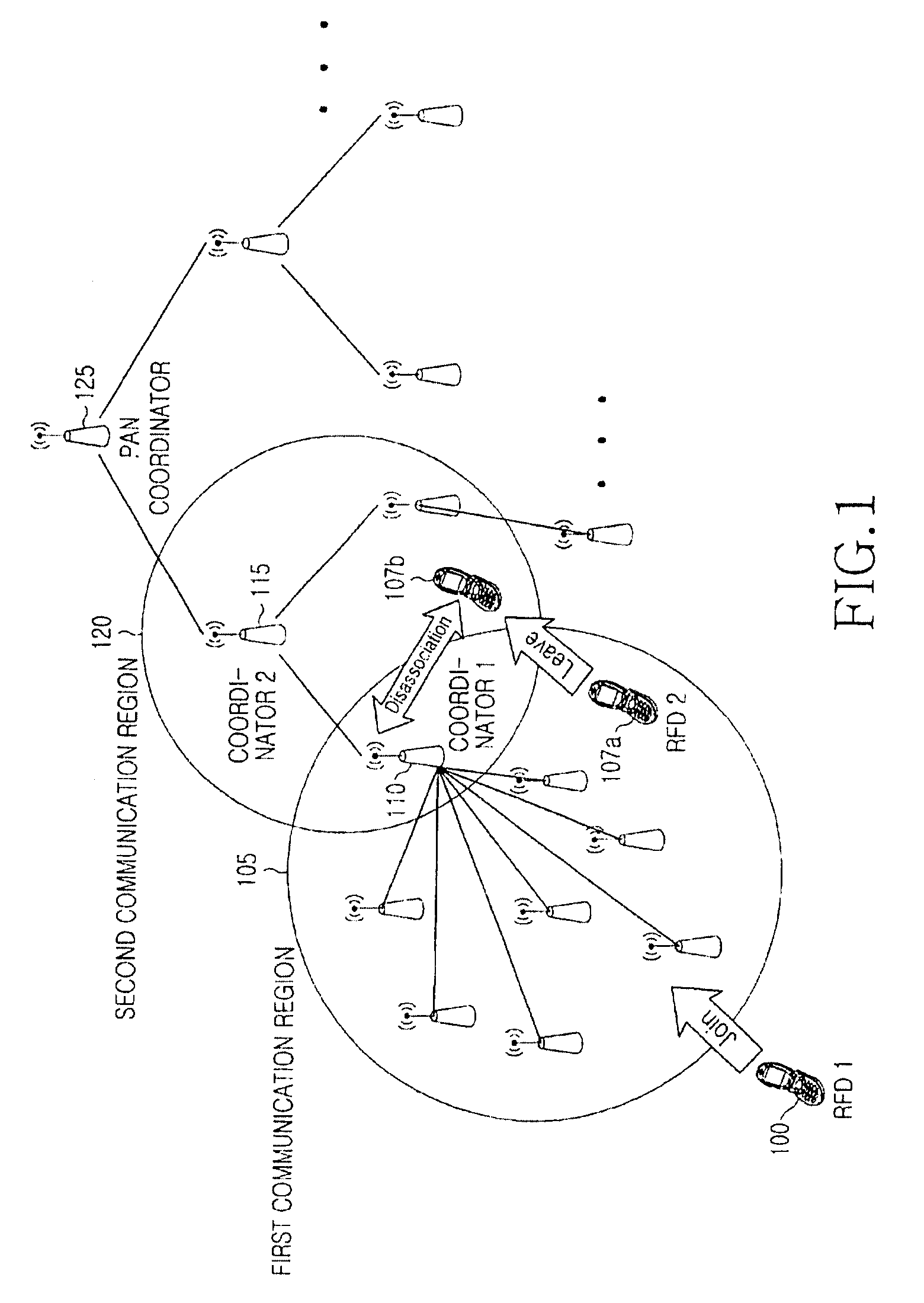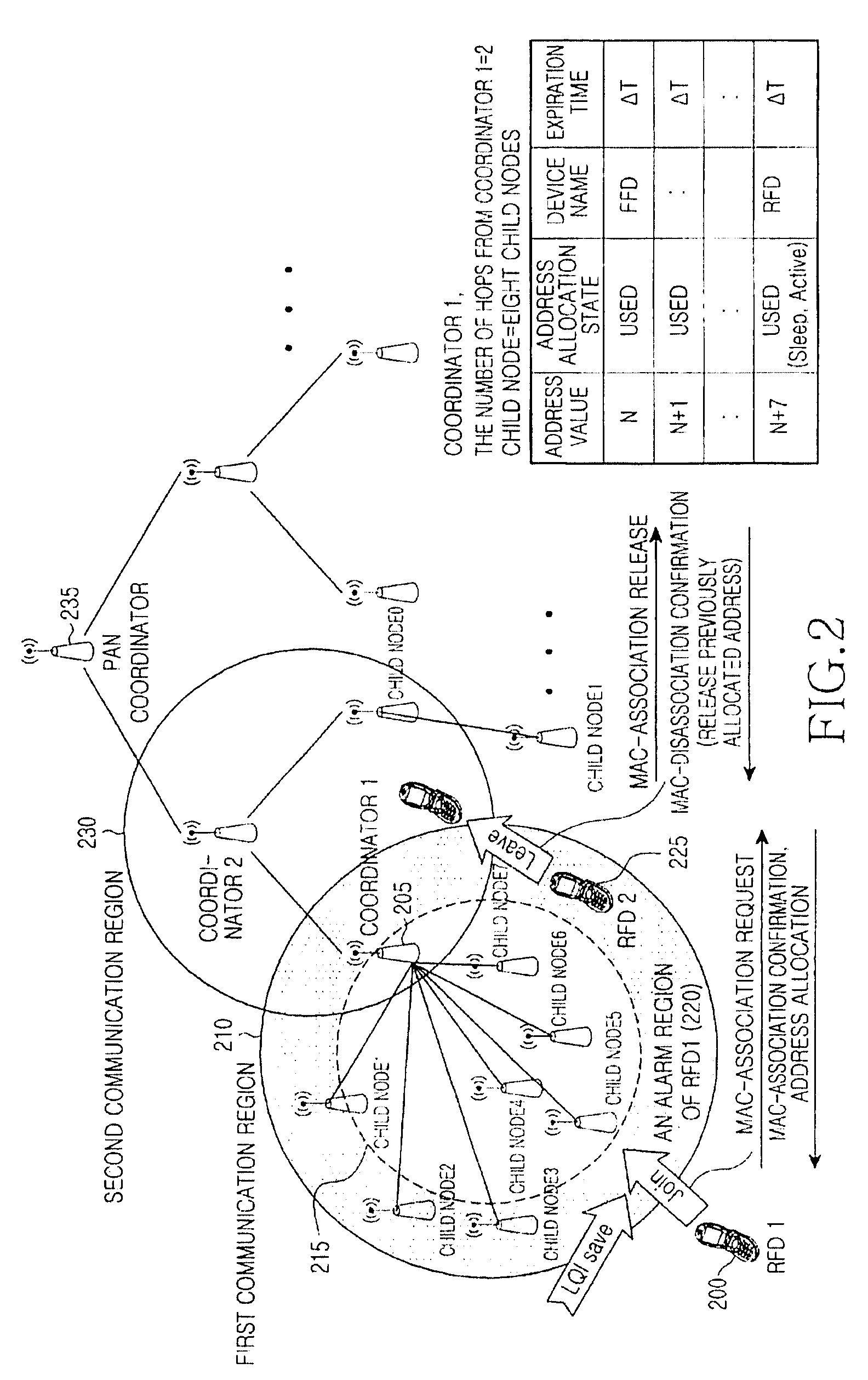Method of managing allocated address in low power wireless personal area network
a wireless personal area network and allocated address technology, applied in data switching networks, high-level techniques, instruments, etc., can solve the problems of difficult application of address management policies (or algorithms) to mobile ip environments with a large amount of data and a wide communication bandwidth, and achieve the effect of efficient allocation of limited addresses
- Summary
- Abstract
- Description
- Claims
- Application Information
AI Technical Summary
Benefits of technology
Problems solved by technology
Method used
Image
Examples
first embodiment
[0042]In the present invention, the subject that performs the alive checking is classified into two cases. That is, the subject may be a parent node that manages certain child nodes, i.e. a coordinator of the communication region, or may be certain child nodes, i.e. RFD mobile nodes.
[0043]FIG. 2 is a diagram explaining the alive checking of the parent node according to the first embodiment of the present invention.
[0044]Referring to FIG. 2, when an RFD 1200 enters into the first communication region 210 of a coordinator 1205, it transmits a beacon data request message to the coordinator 1205. Here, it is assumed that the number of hops in the communication region is 2.
[0045]The coordinator 1205, having received the beacon data request message, registers the RFD 1200 as its neighbor node in its own neighbor node table. the RFD 1200 maps the LQI value when it enters into the first communication region 210 on the address value to store the LQI value. Here, for convenience in explanatio...
second embodiment
[0061]In the present invention, two methods for the RFD to complete the previous MAC-disassociation procedure are provided. In the case where the RFD, which is in the MAC-disassociation procedure, moves to a communication region managed by another coordinator, the RFD completes the previous MAC-disassociation procedure.
[0062]FIG. 4 is a diagram illustrating a first method of completing the MAC-disassociation procedure with the previous coordinator through neighbor nodes according to the second embodiment of the present invention.
[0063]If the non-communication state between the respective coordinators and their child nodes continues for a predetermined time without the completion of the MAC-disassociation between the coordinators and their child nodes, the coordinators broadcast signals for requesting the registration of the child nodes in the non-communication state as orphan nodes. The neighbor nodes, having received the signals, stores the mobile nodes requested to register as orp...
third embodiment
[0077]FIG. 6 is a diagram illustrating a method of completing the MAC-disassociation procedure through an RFD and a coordinator, which are in MAC-association relations with each other, according to the present invention.
[0078]Referring to FIG. 6, an RFD 600 is in a MAC-association state with a coordinator 1605, and transmits / receives data.
[0079]Although it is exemplified that one coordinator 2610 corresponds to the neighbor node of the RFD 600 and the coordinator 1605, a plurality of nodes may actually exist.
[0080]If the RFD 600 moves over one hop from the coordinator 1 and enters into a non-communication state with the coordinator 1605 in step 620, the RFD 600 operates its internal timer, and periodically transmit a MAC-disassociation request message with the coordinator 1605 to its neighbor node, i.e. a coordinator 2610, in step 625. The operating time of the timer corresponds to a time for waiting for a response message to the MAC-disassociation request message from the coordinat...
PUM
 Login to View More
Login to View More Abstract
Description
Claims
Application Information
 Login to View More
Login to View More - R&D
- Intellectual Property
- Life Sciences
- Materials
- Tech Scout
- Unparalleled Data Quality
- Higher Quality Content
- 60% Fewer Hallucinations
Browse by: Latest US Patents, China's latest patents, Technical Efficacy Thesaurus, Application Domain, Technology Topic, Popular Technical Reports.
© 2025 PatSnap. All rights reserved.Legal|Privacy policy|Modern Slavery Act Transparency Statement|Sitemap|About US| Contact US: help@patsnap.com



